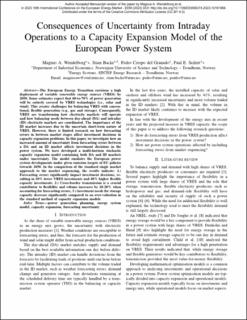| dc.contributor.author | Wendelborg, Magnus Aleksander | |
| dc.contributor.author | Backe, Stian | |
| dc.contributor.author | Crespo del Granado, Pedro Andres | |
| dc.contributor.author | Seifert, Paul Erich | |
| dc.date.accessioned | 2024-01-22T09:53:29Z | |
| dc.date.available | 2024-01-22T09:53:29Z | |
| dc.date.created | 2023-07-06T14:10:36Z | |
| dc.date.issued | 2023 | |
| dc.identifier.citation | 2023 19th International Conference on the European Energy Market - EEM | en_US |
| dc.identifier.isbn | 979-8-3503-1258-4 | |
| dc.identifier.issn | 2165-4077 | |
| dc.identifier.uri | https://hdl.handle.net/11250/3113018 | |
| dc.description.abstract | The European Energy Transition envisions a high deployment of variable renewable energy sources (VRES) by 2050. Some estimates expect that 60-to-70% of power generation will be entirely covered by VRES technologies (i.e., solar and wind). This creates challenges for balancing VRES with conventional, flexible generation (e.g., gas and storage). Consequently, VRES are transforming how electricity markets will operate and how balancing needs between day-ahead (DA) and intraday (ID) electricity markets are coordinated. The importance of the ID market increases due to the uncertain short-term nature of VRES. However, there is limited research on how forecasting errors in between market stages affect investment decisions in capacity expansion problems. In this paper, we investigate how an increased amount of uncertainty from forecasting errors between a DA and an ID market affects investment decisions in the power system. We have developed a multi-horizon stochastic capacity expansion model containing both DA and ID markets under uncertainty. The model emulates the European power system developments under given emission targets of EU policies towards 2050. In the comparison of the standard single market approach to the market sequencing, the results indicate: 1.) Forecasting errors significantly impact investment decisions, resulting in 10% lower VRES investments and 40% higher flexible capacity investments, 2.) Cross-border transmission is a crucial contributor to flexibility and volume increases by 10-20% when accounting for forecasting errors, 3.) investment needs for storage capacity decrease significantly compared to an over-valuation in the standard method of capacity expansion models. | en_US |
| dc.description.abstract | Consequences of Uncertainty from Intraday Operations to a Capacity Expansion Model of the European Power System | en_US |
| dc.language.iso | eng | en_US |
| dc.publisher | IEEE | en_US |
| dc.relation.ispartof | 2023 19th International Conference on the European Energy Market - EEM | |
| dc.relation.ispartofseries | International Conference on the European Energy Market;2023 | |
| dc.rights | Navngivelse 4.0 Internasjonal | * |
| dc.rights.uri | http://creativecommons.org/licenses/by/4.0/deed.no | * |
| dc.title | Consequences of Uncertainty from Intraday Operations to a Capacity Expansion Model of the European Power System | en_US |
| dc.title.alternative | Consequences of Uncertainty from Intraday Operations to a Capacity Expansion Model of the European Power System | en_US |
| dc.type | Chapter | en_US |
| dc.type | Peer reviewed | en_US |
| dc.description.version | acceptedVersion | en_US |
| dc.rights.holder | The Authors hold the copyright to the Author Accepted Manuscript. Distributed under the terms of the Creative Commons Attribution License (CC BY 4.0) | en_US |
| dc.identifier.cristin | 2161248 | |
| dc.relation.project | Norges forskningsråd: 320789 | en_US |
| cristin.ispublished | true | |
| cristin.fulltext | postprint | |
| cristin.qualitycode | 1 | |

